welcome to worldwidewachs.com
Hiking in Patagonia
October 27 – November 15, 2001
October 27 – November 1
Martie has allowed me to report on the Argentine adventures.Your loss.
We had a week to kill between the end of construction in Bolivia and the beginning of our Elderhostel trekking in Patagonia. Buenos Aires seemed like a good place to unwind. And we did so with lazy mornings, evenings of TV and reading, and an abbreviated sight seeing schedule.We walked everywhere – an hour each way to an Indian restaurant – to stay buff for our upcoming treks in the mountains.
Buenos Aires is a typical city with modern skyscrapers, an urbanized wharf area, wide avenues and grand old homes. There was little pure blood as the inhabitants looked European in dress and physiognomy. Even the scavengers rummaging through the garbage were ethnically diverse, rather than the ubiquitous Indians of Cochabamba.
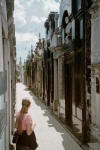
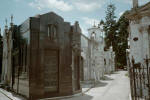 We visited several gardens, a Japanese and a Rose, cruised for restaurants in the wharf area and
roamed the main shopping street, where
We visited several gardens, a Japanese and a Rose, cruised for restaurants in the wharf area and
roamed the main shopping street, where
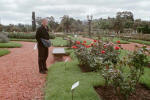 one can never be more than two blocks from McDonalds (why doesn’t South America export churrascarias
or Bolivian salteñas for revenge?). There is a Cementario where Evita Peron is buried along with every who’s who in
Argentina history. It was a fascinating place not only because of the architectural mish-mash, but because
the caskets are on display through glass doors and lesser relatives are racked 3 or 4 high in the “basement”. Add
the quick, and the tourists and RIP is a joke.
one can never be more than two blocks from McDonalds (why doesn’t South America export churrascarias
or Bolivian salteñas for revenge?). There is a Cementario where Evita Peron is buried along with every who’s who in
Argentina history. It was a fascinating place not only because of the architectural mish-mash, but because
the caskets are on display through glass doors and lesser relatives are racked 3 or 4 high in the “basement”. Add
the quick, and the tourists and RIP is a joke.
Another adventure took place at the foot of the Bolivar statue on Libertador Avenue where a lady showed Martie and me we had been splattered by a passing bird. After much gesticulating, turning and wiping, with additional help from her kind husband, we got all cleaned off. Yep, a team of pickpockets. It was a great performance, and were it not that the price of admission was so steep; I would applaud their professionalism. On the bright side, however, it was not bird poop we were splattered with, rather a local Grey Poopon.
Remember, we were in South America where everything is bassackwards from North America.Even the toilet swirls in the opposite direction. So we were in Buenos Aires at the first of November, spring was just arriving with temperatures in the mid 70s ºF, when we hopped on a plane and flew 4 hours SOUTH to El Calafate, followed with a 4-5 hour van drive to the town of El Chalten.On the way, we learned that the Argentine government created El Chalten in 1985 in the mouth of a wide valley, which went a long way toward explaining why such a cold, windy place is where it is.It was in the low 50s ºF when we arrived and the wind battered and moaned at our windows all night.
November 2 – November 5
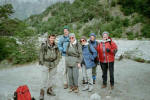 There were six Elderhostelers. Besides Martie and myself, there was Erica from Ohio, Kit, Pat and Joan from Washington
State.They were veteran travelers and seasoned hikers. Daniel was our van driver. Our guide, Merlin, was a young
mountaineer/ski instructor with an easy smile and bottomless cookie tin. The only magic trick I saw him do was provide an excellent experience for
us all.
There were six Elderhostelers. Besides Martie and myself, there was Erica from Ohio, Kit, Pat and Joan from Washington
State.They were veteran travelers and seasoned hikers. Daniel was our van driver. Our guide, Merlin, was a young
mountaineer/ski instructor with an easy smile and bottomless cookie tin. The only magic trick I saw him do was provide an excellent experience for
us all.
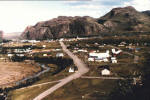 We took three hikes from our lodge, El Puma, in El Chalten, leaving about 9:00 each morning. For
our shakedown hike, we took the van 10 miles up the valley on a dirt road that paralleled the Rio de
las Vueltas (River of Turns). We got dumped out at the head of a well-worn path that meandered uphill through meadows
and woods.We were able to spot glaciers on snow-covered mountains 8 – 12,000 feet above us and look into the
broad green valley 2-3,000 feet below us. Were it not for the 40 ºF air and wind that at least once pushed me off balance
between steps, it was a grand hike on a spring day. Martie’s notes indicate she was getting colder as the day advanced.
I refuse to speculate if my superior metabolism or middle age insulation package kept me in the comfort zone
We took three hikes from our lodge, El Puma, in El Chalten, leaving about 9:00 each morning. For
our shakedown hike, we took the van 10 miles up the valley on a dirt road that paralleled the Rio de
las Vueltas (River of Turns). We got dumped out at the head of a well-worn path that meandered uphill through meadows
and woods.We were able to spot glaciers on snow-covered mountains 8 – 12,000 feet above us and look into the
broad green valley 2-3,000 feet below us. Were it not for the 40 ºF air and wind that at least once pushed me off balance
between steps, it was a grand hike on a spring day. Martie’s notes indicate she was getting colder as the day advanced.
I refuse to speculate if my superior metabolism or middle age insulation package kept me in the comfort zone
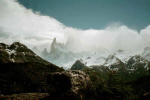 Merlin kept us at his steady “tourist pace” all day and as we started down hill toward town that afternoon, we were rewarded with fleeting glimpses of
Mt. Fitz Roy, as the clouds shredded themselves on the peak. Fitz Roy is a world-class escarpment that has been successfully
challenged by professional alpinists only eight times, if I heard correctly.
Merlin kept us at his steady “tourist pace” all day and as we started down hill toward town that afternoon, we were rewarded with fleeting glimpses of
Mt. Fitz Roy, as the clouds shredded themselves on the peak. Fitz Roy is a world-class escarpment that has been successfully
challenged by professional alpinists only eight times, if I heard correctly.
We got back to El Puma about 5:00 pm. With time for a shower and a geology lesson by a local enthusiast, who told us more about rocks and other schist than we could ever absorb, we headed out to dinner about 8:30.(In South America, if you are in a restaurant before 9:00 pm you are eating with other tourists.)
After a half hour drive (remember all roads out there were gravel, high speed about 40 mph and should the terrain happen to allow two points to be joined by a straight line, they weren’t) we arrived at a small lodge at the edge of Lake Viedma about dusk. The lake sported several icebergs, but in the vastness of the vista, I couldn’t tell you if they were VW or Titanic in size. In a land where sheep was king, we had our first lamb.
The second day’s hike started from El Puma. As we walked through El Chalten, I could see empty buildings, buildings under construction, electric lines running helter-skelter, laundry hanging semi-solid on lines, gravel streets with chuck holes, horses tied at the front gate (actually as we entered a restaurant one evening, a string of ponies galloped down Main vaguely herded by a vintage pickup). Shift venues in time and place and we were experiencing a boomtown during the California Gold Rush days. But I digress.We were out for a 10-12 mile stroll in the mountains, weren’t we?
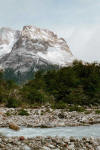
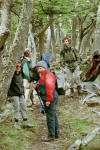 Up the first valley we got the zillion miles an hour wind, making bimodal movement challenging. Even
though the sun was shining, it would occasionally spit rain. We even got a rainbow against the mountain.
As we climbed, the terrain changed into a wooded area with soft spongy earth.The trees, there were 3
different kinds that I never could remember, were twisted and gnarled. The downed timber, either full trees or shattered limbs,
evidenced that life was hard here. Few grew over 30 feet tall.
Up the first valley we got the zillion miles an hour wind, making bimodal movement challenging. Even
though the sun was shining, it would occasionally spit rain. We even got a rainbow against the mountain.
As we climbed, the terrain changed into a wooded area with soft spongy earth.The trees, there were 3
different kinds that I never could remember, were twisted and gnarled. The downed timber, either full trees or shattered limbs,
evidenced that life was hard here. Few grew over 30 feet tall.
Our goal was Lago Torre (Tower Lake). The closer we got the more serious was the rain until finally we were forced into rain gear.Macho Marv didn’t pack sissy rain pants.Macho Marv was reminded that wet pants and wind have an exothermic relationship. Upon reaching Lago Torre we enjoyed the views of the inside of a cloud and a slate gray lake.Informed lunch would be in the woods below, we headed down.
Surprise – we had lunch in a tent at the base camp used for summit assaults on Cerro Torre. As we sat on campstools sipping hot tea, warmth returned.
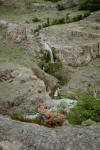 After lunch, we followed a series of folds staying level or slightly downhill. The views improved as the clouds dispersed, especially about an hour
from town. Although we had a grand view of the town in the big valley below, it was spectacular to look across the
valley to our right and follow the meanderings of the Margarita waterfall, a series of small cascades dropping down 1000 feet of mountainside.
Again, we got home about 5:00 PM.
After lunch, we followed a series of folds staying level or slightly downhill. The views improved as the clouds dispersed, especially about an hour
from town. Although we had a grand view of the town in the big valley below, it was spectacular to look across the
valley to our right and follow the meanderings of the Margarita waterfall, a series of small cascades dropping down 1000 feet of mountainside.
Again, we got home about 5:00 PM.
Evening brought us a park ranger to show slides and talk about some of Argentina’s 32 national parks. Again we ate dinner just before bedtime. None of us reported difficulty sleeping.
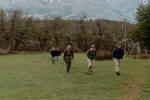 In the morning the wind had died down, so you didn’t
constantly hear the lodge being battered.(A
winter storm there about 4 years ago had winds measured around 220 kilometers per hour – 130 mph!) Our hike left from
the ranger station on the other side of town.
We climbed for about 3 hours along mountainsides, through dandelion
meadows, a big boggy area where any weight on the soil brought water over your
shoe soles, and the now familiar forests of gnarled fir trees.
Eventually we got above some snow patches and crossed a creek with
icicles hanging over the water.
In the morning the wind had died down, so you didn’t
constantly hear the lodge being battered.(A
winter storm there about 4 years ago had winds measured around 220 kilometers per hour – 130 mph!) Our hike left from
the ranger station on the other side of town.
We climbed for about 3 hours along mountainsides, through dandelion
meadows, a big boggy area where any weight on the soil brought water over your
shoe soles, and the now familiar forests of gnarled fir trees.
Eventually we got above some snow patches and crossed a creek with
icicles hanging over the water.
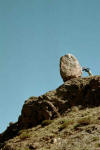
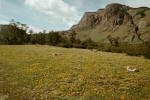 After a cozy lunch on the lee edge of a wood in the sun, we elected to start back. Our original goal was experiencing a snow shower and offered
no reward for the effort upward. Our decision to go down was rewarded with some of the clearest views yet of Fitz
Roy.By the time we got back to the ranger station the whole chain was standing clear, posing for a panorama shot.
One other phenomenon, shown here, was a balancing rock, left by a receding glacier a millennium or so ago. I
was unsuccessful in pushing it over and too chicken to tug on the key rock.
After a cozy lunch on the lee edge of a wood in the sun, we elected to start back. Our original goal was experiencing a snow shower and offered
no reward for the effort upward. Our decision to go down was rewarded with some of the clearest views yet of Fitz
Roy.By the time we got back to the ranger station the whole chain was standing clear, posing for a panorama shot.
One other phenomenon, shown here, was a balancing rock, left by a receding glacier a millennium or so ago. I
was unsuccessful in pushing it over and too chicken to tug on the key rock.
The evening’s lecture was by Alberto, an Alpine climber and part owner of our lodge.He gave us the history of climbing Fitz Roy and Cerro Torre. He explained and demonstrated climbing equipment. We learned because of so little good climbing weather, an assault on Fitz Roy must be completed round trip from the high camp in 36 hours. I’ll wait for the installation of elevators.
Mt Fitz Roy Panarama
November 6 – 8
We drove 4-5 hours today to reach Helsinfors estancia (ranch). The road from El Chalten
took us back through the Steppes around Lago Viedma. The Steppes are an arid, yellow and brown area where fortunes were made
on huge estancias before the collapse of the wool market decades ago. Main ranch houses must be 20 miles apart.
In between we saw a few small herds of sheep and the occasional guanaco, a wild llama relative.
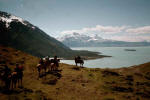
Because a bridge was out, two ranch vehicles met us. The luggage was loaded and driven over a ford
downstream. We crossed the river on a cable footbridge. It was not OSHA approved. Then we were picked up and driven the last 20 minutes to the
estancia. If I ever get to heaven, it will contain a slice of Helsinfors. These pictures, showing the land around the house, barely do it justice.
The meals were some of the best of the trip. And the estancia had horses!
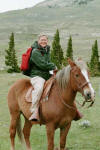
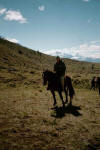 The first thing I did after dumping my bag in the room was to join Daniel and Merlin for a ride. The saddles felt
different than our western saddles and I couldn’t seem to get my tennis shoes into the stirrups right, but despite not having ridden for some years,
I was doing OK. Then we galloped. First, I was thinking that if the stirrups were wider I could
get my tennis shoes in to the ball of my foot, then I was thinking that I ought to put my left foot back in its stirrup before the right one came out too.
Next thought contained a mental snapshot of a horse’s rump framed by my shoes. Gravity sucks!
The first thing I did after dumping my bag in the room was to join Daniel and Merlin for a ride. The saddles felt
different than our western saddles and I couldn’t seem to get my tennis shoes into the stirrups right, but despite not having ridden for some years,
I was doing OK. Then we galloped. First, I was thinking that if the stirrups were wider I could
get my tennis shoes in to the ball of my foot, then I was thinking that I ought to put my left foot back in its stirrup before the right one came out too.
Next thought contained a mental snapshot of a horse’s rump framed by my shoes. Gravity sucks!
Despite my fall and despite a low quantum of riding experience, the whole group decided to ride to Lago Azul (Blue Lake) the next day. What would have been a 4-5 hour uphill slog turned into a wonderful 3-hour trail ride through a steep valley with the trail running along with the creek that emptied Lago Azul. The meadows were filled with yellow violets, lady slippers and anemones and the sky had enough condors to keep Kit, our most avid bird watcher, happy.
high andean glacial lake
The lake was, duh!, blue from the glacier detritus dissolved in it. The view was spectacular. After lunch while others wandered to the other side, I found a sunny spot in the lee of a large boulder, ideal for glacier watching. Despite numerous cannon-like reports from up the mountains, no slides or calving could have been reported nor were there any light leaks in my eyelids. As our mounts picked their way back down the steep path, we were treated to the scenery we missed climbing up. Days don’t get much better than this.
The owners of Helsinfors also own Los Hermanos, a neighboring estancia which we visited as we left for El Calafate the next
day.Here we learned about raising sheep while visiting the shearing barn.
Today the price of wool is so depressed Los Hermanos has only a few hundred sheep and raises mostly cattle on its 10,000 hectares (25,000 acres).
Our tourist dollars keep the creditors at bay.
We broke our return once again for a leg stretch at a petrified forest. What are the odds the biggest tree for hundreds of miles
around is petrified?
In El Calafate we were ensconced in a hotel on a hill overlooking the town where once again the winds complained continuously about our intrusion.For those of you thinking Kansas is windy, mark it mildly breezy. Patagonia is windy.
November 9 – 11
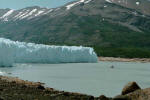
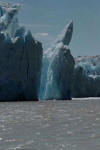 Today we visited the Perrito Moreno Glacier – a two-hour drive followed by a cold boat ride. A
crowd of 40 or 50 of us got off at the dock/ranger station and were divided about 50/50 into an English or Spanish speaking group.
Our guide parked us on a sandy beach facing the glacier where he
explained that the Patagonian ice field is the third largest glacier field after
Antarctica and Greenland. He used the sand as a blackboard to augment his lecture.
As he spoke a huge berg calved 2 miles across the bay, throwing spray and making a huge splash. Good thing
there was no test because the resulting tsunami washed his diagrams off the beach.
Today we visited the Perrito Moreno Glacier – a two-hour drive followed by a cold boat ride. A
crowd of 40 or 50 of us got off at the dock/ranger station and were divided about 50/50 into an English or Spanish speaking group.
Our guide parked us on a sandy beach facing the glacier where he
explained that the Patagonian ice field is the third largest glacier field after
Antarctica and Greenland. He used the sand as a blackboard to augment his lecture.
As he spoke a huge berg calved 2 miles across the bay, throwing spray and making a huge splash. Good thing
there was no test because the resulting tsunami washed his diagrams off the beach.
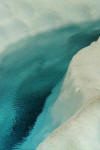 Next we went to the glacier edge where we donned crampons, got crampon walking 101 and headed out over the glacier for an hour and a half.
Everything was white and blue. In the water filled fissures you could see meters below the surface through
crystalline blue water.The grand
Next we went to the glacier edge where we donned crampons, got crampon walking 101 and headed out over the glacier for an hour and a half.
Everything was white and blue. In the water filled fissures you could see meters below the surface through
crystalline blue water.The grand
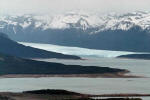 finale was Argentine scotch over glacier ice.
finale was Argentine scotch over glacier ice.
After a box lunch, we re-boarded the boat for the mandatory cruise by the glacier face. After landing, we also took a 4 km trail on the brush and bloom covered hillside opposite Moreno. Despite constant cracking, booming and a few small splashes, we never saw another big calving. Camera shy, I guess.
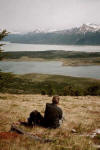
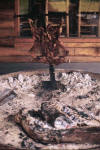 The next day we left about 9:00 am, taking the van along
the south side of Lago Argentina, stopping for a three hour hike up a mountain
with postcard panoramas of an estancia and the Perrito Moreno Glacier
before arriving at Nikepo Aike estancia for an asado (barbecue).
Theirs was a typical method: an open fire reduced to coals on one side of a 6-foot circle.
Fresh lamb was spread-eagled on a special rack where it stood for some hours before the fire. I can attest
that the results met high standards and the carnivores ate until foundering.
The next day we left about 9:00 am, taking the van along
the south side of Lago Argentina, stopping for a three hour hike up a mountain
with postcard panoramas of an estancia and the Perrito Moreno Glacier
before arriving at Nikepo Aike estancia for an asado (barbecue).
Theirs was a typical method: an open fire reduced to coals on one side of a 6-foot circle.
Fresh lamb was spread-eagled on a special rack where it stood for some hours before the fire. I can attest
that the results met high standards and the carnivores ate until foundering.
November 12 – 14
Yesterday afternoon we flew into Ushuaia (you-shwhy-ah), the southernmost city in the world. As we circled to land, we could see snow-covered peaks as the Andes marched into the sea, leaving numerous islands in their wake. Ushuaia has 45,000 inhabitants glued to a hill above the Strait of Magellan. The original population was primarily prisoners. It is not surprising that the smell of normalcy is absent from the air. Truly, here is the end of the earth. Architecture, for example, extends from South American-style stucco through Swiss chalet to A-frame vacation and finally to “What should we do with this packing crate, Daddy?”
Our hotel was perched half way up a large mountain offering
commanding views of peaks and glaciers out of the back, with town and harbor at our feet. After breakfast on linen
tablecloths, we vanned to Tierra del Fuego National Park for a hike. It was an easy 5-hour hike along lakes, bays and rivers wending in and
out of the woods. It was alternately rainy and sunny, but the wind was not of the previous caliber.
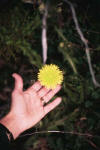 Merlin told us about the Yamana Indians who lived here years ago. They survived off the sea, practically living in their canoes. Rather
than hang out in wet clothes and risk discomfort, they chose to live naked instead. Those hardy people died
out after the arrival of the white man, who decimated the seal population and imported diseases.
Merlin told us about the Yamana Indians who lived here years ago. They survived off the sea, practically living in their canoes. Rather
than hang out in wet clothes and risk discomfort, they chose to live naked instead. Those hardy people died
out after the arrival of the white man, who decimated the seal population and imported diseases.
Late afternoon found us at the Maritime Museum, housed in the old prison, which was built in 1902-1911. Aside from the obvious purpose, the prison gave Argentina presence in the area and kept Chile from staking a claim. The cellblocks offered thumbnail histories of their more notorious occupants as well as exhibits on the Yamana, Antarctica and the history and events surrounding Ushuaia.
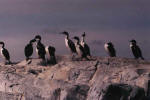
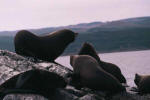 Our last full day in Patagonia began with a wildlife lecture including pictures of whales, seals and various local birds.
The lecture was punctuated by fireworks and drums from a group of demonstrators outside protesting because a sister hotel had been closed without
paying their back wages.
Our last full day in Patagonia began with a wildlife lecture including pictures of whales, seals and various local birds.
The lecture was punctuated by fireworks and drums from a group of demonstrators outside protesting because a sister hotel had been closed without
paying their back wages.
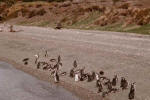
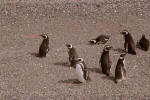 Our group repaired to the docks where we caught a
catamaran for a tour of the islands, the Beagle Channel, and a visit to the
Harberton estancia. En
route, we stopped for sea lion and penguin (Magellanic and Papua/Gentoo)
watching. At the estancia,
we were toured through the gardens in full bloom, various sheep shearing sheds
and a super maritime museum exhibiting the skeletal remains of various sea
creatures including a whale collected locally by a past mistress of the estancia. The evening was capped with a farewell feast at the hotel.
Our group repaired to the docks where we caught a
catamaran for a tour of the islands, the Beagle Channel, and a visit to the
Harberton estancia. En
route, we stopped for sea lion and penguin (Magellanic and Papua/Gentoo)
watching. At the estancia,
we were toured through the gardens in full bloom, various sheep shearing sheds
and a super maritime museum exhibiting the skeletal remains of various sea
creatures including a whale collected locally by a past mistress of the estancia. The evening was capped with a farewell feast at the hotel.
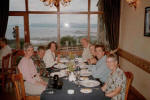 The next morning we began our long, arduous, unbroken, but
most importantly, uneventful, return home.
The next morning we began our long, arduous, unbroken, but
most importantly, uneventful, return home.

